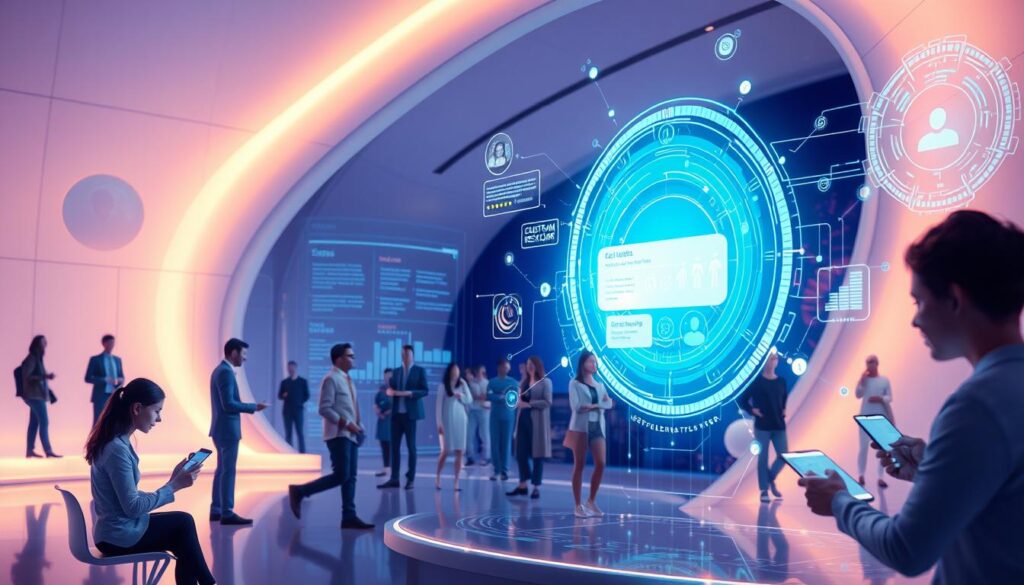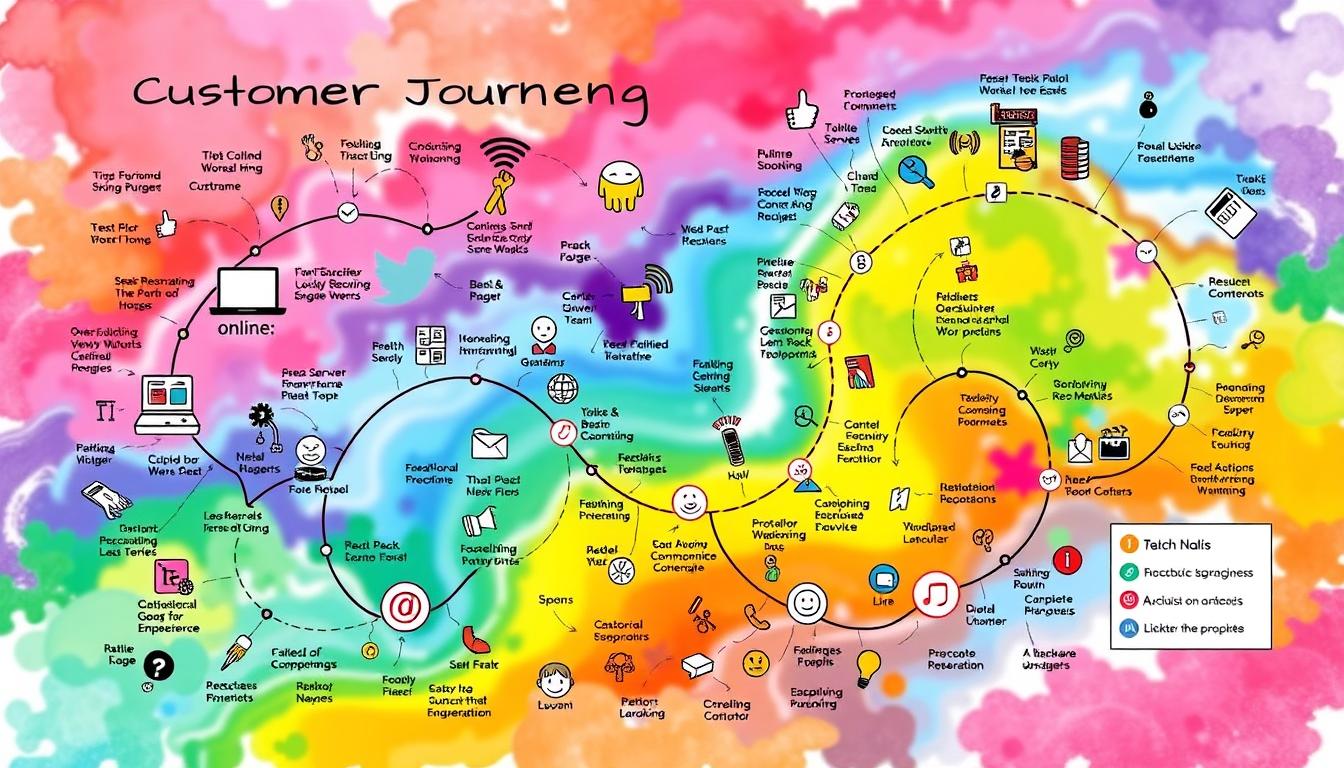Have you ever thought about how answering customer reviews could change your business? Today, making customers happy is key for businesses in all fields. Over 45% of companies are now spending more on making customers happy, up from 36% in 20101.
Putting a focus on making customers happy really pays off. Companies that aim for great customer experiences make 60% more money than those that don’t1. It’s not just about making more money; it’s about building strong bonds with customers. Brands that do a great job with customer experience keep customers for up to six years and these happy customers spend 140% more1.
But, surprisingly, less than half of all companies really make customers happy1. This is a big chance for businesses to get better at making customers happy. By using customer feedback, online reviews, and focusing on loyalty, companies can make a big difference.
Answering reviews is more than fixing problems; it’s a way to make a big change in customer experience. It tells customers you care about what they say, building trust and loyalty. In fact, 58% of customers are ready to pay more for a better experience1. By having a strong plan for customer experience that includes good review responses, businesses can make more customers happy and increase sales.
Key Takeaways
- Investing in customer experience can significantly boost profits and loyalty
- Responding to reviews is crucial for building trust and fostering brand loyalty
- Most companies still fall short in delivering excellent customer experiences
- Customers are willing to pay more for better experiences
- A strong CX strategy can set businesses apart in a competitive market
The Power of Customer Experience in Today’s Business Landscape
In today’s fast-paced business world, customer experience is key. Companies that focus on their customers do much better. They are 60% more profitable than those that don’t2. They can even charge up to 16% more for their products or services2.
The customer journey is now more complex. Most shoppers use multiple channels, making seamless experiences crucial2. We must map out every step of this journey to understand our customers better.
Now, customer experience is the main way companies compete for 88% of businesses2. This change comes from how consumers behave. Research shows 72% of consumers feel things like inflation and climate change affect their lives more now3.
Some companies are getting creative to keep up. For example, DoorDash makes all employees, even executives, deliver food monthly. Their aim is to improve service “1% every day” by connecting with customers directly4.
Keeping customers is key. It’s much cheaper to keep existing customers than to find new ones2. But, one bad experience can make 61% of customers switch to a competitor2.
The future of customer experience is about seeing customers as more than buyers. We need to understand their diverse needs and how they behave3. By focusing on great experiences and engaging with customers in new ways, we can increase loyalty and growth in this changing business world.
Empowering Employees: The Foundation of Exceptional Customer Experience
Employee engagement is key to a customer-centric culture. Companies that focus on their workers see a 20% jump in customer happiness5. This shows how important it is to have empowered employees for happy customers.
Creating a culture that puts customers first has big rewards. These companies see a 20% rise in worker engagement and a 15% increase in customer satisfaction5. To get these results, we must value what employees think and say, especially those who talk to customers every day.
Training employees on customer experience brings real benefits. Companies that train their staff see a 10-15% boost in customer happiness5. This training helps employees make better CX choices, leading to a 15-20% increase in customer satisfaction5.
To see these gains, businesses should use tools like employee pulse surveys and suggestion boxes. These tools help find problems and get important feedback. Companies that listen to their employees and act on their feedback see a 20% increase in customer satisfaction5.
| Strategy | Impact on Customer Satisfaction |
|---|---|
| Engaging entire workforce in CX | 20% increase |
| Building customer-centric culture | 15% increase |
| Regular CX training for employees | 10-15% improvement |
| Empowering employees for CX decisions | 15-20% increase |
Even with the benefits, there are challenges. Deloitte says 55% of companies find it hard to empower employees because of consistency issues and lack of training5. It’s important to overcome these challenges for a truly customer-centric culture that leads to great experiences.
Leveraging Technology to Enhance Customer Experience
We’re seeing a big change in how companies talk to customers thanks to digital tech. AI and machine learning are changing the game. Now, AI chatbots offer help any time, making customers happier and helping businesses grow6. These chatbots talk to customers right away, giving them quick help and understanding their needs7.
Natural language processing lets companies understand what customers say on a big scale. This tech gives companies deep insights into what customers like and don’t like. By 2025, companies that use data and tech well will make experiences that feel just right for each customer8.

Today, having a good approach across all channels is key. Customer Experience Management systems use AI and analytics to make sure every interaction is top-notch7. This means customers get the same great experience whether they’re on their phone, computer, or in a store.
| Technology | Impact on Customer Experience |
|---|---|
| AI-driven Chatbots | 24/7 support, improved satisfaction |
| Natural Language Processing | Deeper customer insights |
| Omnichannel CXM Systems | Consistent experience across channels |
| Virtual/Augmented Reality | Immersive product experiences |
Virtual and augmented reality make experiences feel real, helping customers get to know products better and connect more with brands7. These techs, along with AI-driven personal touches, are setting new highs in how companies talk to customers.
Embracing digital technology isn’t just about being efficient—it’s about making real, personal connections with customers.
In this tech-filled world, using AI, machine learning, and an omnichannel approach is a must. It’s the key to giving customers amazing experiences in our digital lives.
Personalization: The Key to Customer Loyalty
Personalization has changed the game in customer experience. Now, most shoppers are changing their habits and plan to keep doing so9. This shows how important it is to connect with customers in a unique way.
Companies that get personalization right see big wins. They make 10-15% more money on average, with some industries seeing up to 25% more9. This means a huge opportunity for businesses in the US, potentially adding over $1 trillion in value9.

Personalization’s strength is in building strong connections. Over 78% of consumers are more likely to buy again from brands that know them well9. This shows how key it is for building loyalty.
| Personalization Strategy | Impact on Customer Behavior |
|---|---|
| Customized survey questions | Increased engagement and feedback quality |
| Geolocation technology | Relevant local offers and recommendations |
| Purchase history-based suggestions | Higher likelihood of repeat purchases |
| Personal follow-ups | Improved customer satisfaction and loyalty |
| Dynamic content | Enhanced user experience and engagement |
We use customer data and purchase history to make interactions personal. Geolocation tech gives us location-specific deals. Dynamic content changes based on what users like, making things smoother for them.
By 2025, making customers happy will be even more important for businesses to grow10. It will be a key way for banks to draw in and keep customers10. Focusing on personalization now sets us up for success in a tough market.
Customer Experience: Strategies for Success
Customer-centric strategies are key for business growth. A huge 86% of buyers pay more for a great experience11. Let’s look at some ways to boost your customer experience.
Customer journey mapping shows how customers feel and what they do. It helps spot issues and chances to get better. Surveys with open-text feedback give deep insights into what customers think.

Natural language processing changes how we look at customer feedback. It can handle lots of written feedback, giving us important insights. Companies using this tech often see big CX improvements.
Creating a customer-focused culture is essential. It should start at the top and spread throughout the company. Companies that focus on great customer experiences do 80% better11.
| CX Strategy | Impact |
|---|---|
| Customer Retention | 5% increase can boost profitability by 75%11 |
| Personalized Marketing | Up to 15% increase in customer satisfaction11 |
| Proactive Customer Service | 20% increase in sales11 |
Using these strategies and focusing on CX metrics helps build strong customer relationships. Remember, 70% of buying experiences come from how customers feel treated11. Put your customers first, and they’ll support you.
Improving Customer Service to Elevate Overall Experience
Customer support is key to a great customer experience (CX). It sets a business apart and can make or break it. In fact, CX is now the top priority for business pros, ahead of product and pricing, according to a survey of 1,920 people12.
To make the experience better, companies need to work on their customer service. This means offering support through many channels, making sure to respond quickly, and using metrics like CSAT, CES, and NPS. Those who focus on CX tend to see more revenue growth13.

Offering support through many channels lets customers pick how they want to communicate. Now, over 80% of companies invest in an omnichannel experience, up from 20% before12. This approach leads to a 10% yearly growth and a 25% boost in closing deals12.
Speed and ease matter a lot to customers. Almost 80% of US consumers say speed, convenience, and helpful service make for a good experience14. In fact, 69% were happy when the service team was fast to help13.
Businesses use different tools to check how well their customer service is doing. Surveys, NPS, and CES scores help spot customer issues and measure satisfaction14. These tools help companies improve and keep customers coming back12.
Conclusion: Transforming Customer Experience Through Effective Review Responses
We’ve seen how good review responses can change how customers feel. In today’s world, it’s key for businesses to really listen to what customers say. A big 56% of people change their view of a company based on how it handles reviews15.
Being able to listen and make changes based on feedback is what keeps customers coming back. Fixing problems fast can turn a bad situation into a good one. By making our answers personal and making real changes, we show we care about getting better15.
Now, 93% of companies are working hard to make customer experiences better. This focus on making things better for customers leads to more loyalty and growth16. To stay ahead, we need to use tools like real-time data and predictive analytics. These help us understand customers better and make experiences that connect with them on a deeper level16.
Happy employees mean happy customers. By creating a work culture that values everyone’s input, we make sure our team gives top-notch service. Let’s keep pushing the boundaries of what we do for our customers, always keeping them at the center16.
FAQ
How can responding to customer reviews improve customer experience?
Why is customer experience so important in today’s business landscape?
How can empowering employees contribute to exceptional customer experience?
How can technology enhance customer experience?
Why is personalization important for customer loyalty?
What are some strategies for successful customer experience?
How can improving customer service elevate the overall customer experience?
Source Links
- Why Customer Experience Is Key to Scaling Revenue Growth – https://www.superoffice.com/blog/customer-experience-strategy/
- The Importance of Customer Experience in Business Success – https://www.superoffice.com/blog/importance-of-customer-experience/
- What is Customer Experience & Why is It Important – https://www.accenture.com/us-en/insights/song/customer-experience-index
- Customer Experience Is Everyone’s Responsibility – https://hbr.org/2023/04/customer-experience-is-everyones-responsibility
- Customer Experience (CX) is Everyone’s Responsibility: Empowering Employees – https://www.renascence.io/journal/customer-experience-cx-is-everyones-responsibility-empowering-employees
- Leveraging Technology to Improve the Customer Experience | Grassroots IT – https://www.grassrootsit.com.au/blog/leveraging-technology-to-improve-the-customer-experience/
- Leveraging Technology to Improve Customer Experience – Inspiro – https://inspiro.com/insights/blog/leveraging-technology-to-improve-customer-experience/
- The Role of Technology in Enhancing Customer Experience (CX) – https://www.renascence.io/journal/the-role-of-technology-in-enhancing-customer-experience-cx
- Personalization: A Key Driver of Customer Loyalty in 2024 – Wallet Factory – https://walletfactory.com/blog/personalization-in-customer-loyalty-2024-for-retail-finance-and-power-industries
- The Impact on Customer Loyalty – https://www.renascence.io/journal/customer-experience-cx-and-personalization-the-impact-on-customer-loyalty
- Customer Experience and Strategies for Improvement – Ledger – https://campuspress.yale.edu/ledger/customer-experience-and-strategies-for-improvement/
- Key Customer Experience Statistics to Know – https://www.superoffice.com/blog/customer-experience-statistics/
- How to Improve Customer Experience – https://blog.hubspot.com/service/how-to-improve-customer-experience
- 8 steps to delivering stellar customer experiences – https://www.oracle.com/cx/improve-customer-experience/
- 6 Ways to Improve Customer Experience(CX) with Customer Feedback – https://rapidr.io/blog/improve-customer-experience/
- Customer Experience Transformation | InMoment – https://inmoment.com/blog/customer-experience-transformation/

